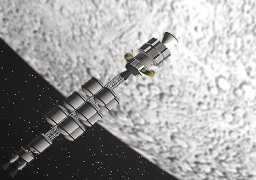

The CEV interaction with the rack
One of the advantages of the rack is as a safe staging area for a normal or an emergency return. The thought was that the CEV actually arrives at the rack, and parks an earth return vehicle (a gumdrop shaped vehicle like the apollo CSM which is the main crew vehicle on the front of the CEV) on the rack for the return. Now a lot of views of the CEV show it as a kind of integrated unit with the gumdrop shaped crew vehicle on the front. Once attached to the rack this return vehicle can be cabled to the power systems of the rack but has its own fuel supply and rocket for lunar-earth transit (but could refuel from the rack too or get more oxygen). This vehicle would be parked on the rack where the initial buried pressurized hab was.
The CEV would then release a pressurized lunar lander with crew on board which is a duplicate of the one that is buried. This pressurized hab could be parked behind the gumdrop shaped earth return vehicle segment so that indeed once the assemblage is attached to the rack a shroud surrounding that pressurized lander could be pulled back as the main body of the CEV motor stage reverses with RCS thrusters. Once the spent motor stage of the CEV pulls away from the rack to expose the lander, the crew would transfer to the pressurized lander which would detatch from the earth return gumdrop and go down for lunar landing. They actually may leave no crew member on the earth return vehicle still attached to the rack (unlike apollo). Now this detaching and attaching is a bit complicated as there has to be a node to allow the crew through between vehicle segments but it would have to be behind where the return gumdrop attaches to the rack so...
A better way for the CEV to park its stuff with the rack
Better to do an apollo style ballet move wherein the gumdrop earth return crew vehicle section pulls away from the CEV motor stage, turns around and docks with the pressurized lander, pulls it out of the CEV motor stage shroud then docks the whole assemblage to the rack (is grabbed by the arms after its RCS puts it in range), so that the earth return gumdrop motor is actually facing toward the rack with the docking cone end is facing away for easy access to the lander. The crew transfers to the lander and off they go. Just thinking out loud (in text) here! I think this is the most viable approach (Von Braun was right!). The only thing different from this and Apollo is that 1. this ballet happens in lunar orbit instead of earth orbit, 2. there is a prepared base with telerobotics facilities to go to and 3. the return vehicle is parked on this rack in lunar orbit and contains backup services.
To the lunar surface
The crew upon reaching the surface could transfer into the buried hab for a safe stay while using the other lander as the return vehicle and a backup hab. Ideally the return vehicle would be physically connected to the buried hab but this may be too complicated a move to do early on. If needed the buried hab is a backup return vehicle as it keeps its onboard rocket fuel. Of course it would have to be unburied somewhat or be able to use its motor to push the material off (a bit of risk there). Oxygen could come from either lander or even the dual rover package could have backup oxygen on board. Ultimately any crew rotating through the base would fill up with spare oxygen at the rack as well.
Leaving the moon
On leaving the Moon, the crew would use an apollo style launch to and rendezvous with the gumdrop shaped (with motor/tanks of its own) return vehicle parked at the rack. That vehicle detaches and motors away for a fast return to earth or docking with the ISS but most likely return via direct descent like Apollo.
The Earth return vehicle is always available on the rack (presumably easily accessible) with extra power, oxygen etc. Over time more vehicles/rovers and supplies would parked at the rack by subsequent CEV visits. The rack is therefore a service station (not a space station) for all phases of surface mission support.
Credits
Created at DigitalSpace, Santa Cruz CA, USA and DM3D Studios, Maffra, Victoria, Australia
We would especially like to acknowledge the support and informative guidance of Raytheon, The Colorado School of Mines Center for Commercial Applications of Combustion in Space (CCACS), and various individuals at NASA. We would also like to thank the following for providing information sources and guidance for this concept visualization:
HOPE / RASC studies (referenced by NASA JIMO/Prometheus)
The Lunar Base Handbook, Peter Eckart
John Frassanito & Associates
Boeing
ESA
Back to Main page
[Click here] to go back to the main page.
Detailed Mission Simulation Breakdown

[Click here] for a detailed mission segment-by-segment breakdown of this simulation, with commentary